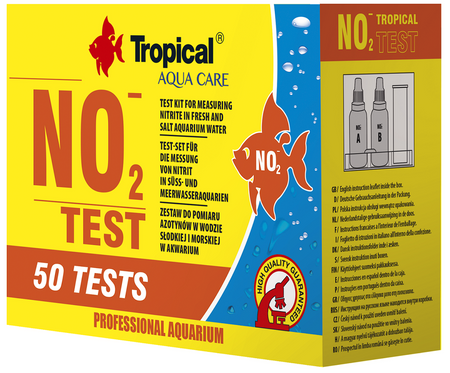- The NO2 test is used to determine the concentration of nitrite (NO2-) in fresh and seawater, with values ranging from 0.0 to 3.3 mg/l. Pack of 50 tests.
Tropical NO2 Test 50 Tests - Product description
What is the source of nitrite (NO2-) in the aquarium?
Fish faeces, uneaten food and other organic debris that accumulate in the aquarium are broken down by bacteria, and one of the products of this process is the dangerous ammonium ions (NH4+), which in alkaline water (pH>7) partially convert to the highly toxic ammonia (NH3) for fish. In a mature and well-functioning aquarium, ammonium ions are oxidised by nitrifying bacteria to less toxic nitrite (NO2-) in the nitrification process, and then to relatively fish-safe nitrate (NO3-). In such aquaria, the concentration of nitrite (NO2-) is close to zero.
Why should nitrite concentration in an aquarium be controlled?
Fish are sensitive to even low concentrations of nitrite (NO2-) in the water. Values below 0.3 mg NO2-/l are considered a safe level. The TROPICAL NO2- TEST should be used especially for new aquaria where the nitrifying bacteria population has not yet developed sufficiently. In addition, mature tanks treated with germicides, over-fertilised aquaria or aquaria in which the fish are overfed should also be checked.
Tropical NO2 Test 50 Tests - Technical data
- Quantity: 50 tests
Additional information
In a properly functioning aquarium, nitrite concentration is close to zero. However, there are situations where the nitrite concentration rises rapidly, which can be caused by:
Insufficient nitrifying bacteria population in the new aquarium.
Overwatered aquarium.
Overfeeding of fish.
Dead fish that have not been removed.
Use of drugs that have a killing effect on nitrifying bacteria.
Insufficient oxygen for nitrifying bacteria resulting from inadequate aeration, prolonged power outages, filter shutdowns or failures.
Cleaning or replacement of all filter cartridges at the same time.
Method of use:
Rinse the vial 3 times with aquarium water.
Fill the vial with 5 ml of test water.
Add 7 drops of reagent A and mix.
After 15 seconds, add 7 drops of reagent B and mix.
After 10 minutes, compare the colour of the test water with the colour scale provided. Take a reading from above in daylight.
After the analysis, rinse the vial thoroughly under running water.



